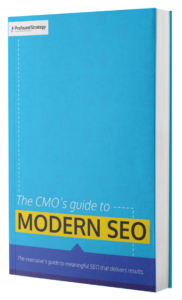SEO Results: How Long Does it Take?
The timeframe for an SEO strategy might be one of the most hot-button issues in the industry. Brands are in a hurry: they want to know when they can see results and how quickly they can report success (or failure). SEOs, however, know that their business is a long-term strategy in a constantly evolving industry with no real guarantees.
There has to be a middle ground. Even the most understanding executives still need to know if a marketing strategy is working, and even the best SEOs need to be accountable to report some kind of progress.
We’ve developed a rough timeline for SEO, based on our experience: results begin within two to three months and should start impacting revenue at the end of six months.
Month 1: Developing a Strategy
Start by making sure you understand your current situation so you can create a framework for priorities and tactics. SEO effort splits into two strains, and both need to be considered:
- Technical SEO—The coding, algorithmic solutions, site structure, etc.
- Engagement SEO—All aspects of your site contributing to a good user experience
Some of the most important technical SEO considerations will need to be taken care of up-front, as they can be barriers to entry in the SEO playing field. As you develop an on-going strategy, be sure to identify technical red flags:
- Website speed
- Mobile usability
- Search engine penalties
- Crawlability and indexing
Issues here will prevent your site from gaining any kind of SEO traction. Crossing them off the To Do list is crossing the Start line on your SEO strategy.
The bulk of your strategy moving forward will likely be engagement SEO work, based on thorough keyword and user intent research. Some form of keyword research—mostly mechanical and routine—has always been a part of building an SEO strategy. As search engines have become more sophisticated over the past few years, however, the way we use keywords has also been forced to change. Today, keywords without user intent insights are virtually worthless.
User intent research is how we learn about an audience’s pain points and needs, and it is the real foundation for an effective pairing of SEO and content marketing. With user intent research in hand, you can construct an editorial calendar that maps out the writing and repurposing of content in a way that will drive engagement and revenue.
Months 2 and 3: Signs of Life
Now it’s time to get to work:
- Fix those critical, technical issues that you identified ASAP.
- Align your existing content to searchers’ needs.
- Get to work publishing new content, and be sure to promote your content like crazy.
After three months of clean technical SEO and strategic engagement SEO content, you should expect to see signs of life. This may not yet be significant growth in bottom-line metrics, but your team should be able to demonstrate movement and trends that are indications of future growth:
- Improved rankings for some of your targeted keywords, perhaps starting with long-tail terms
- An uptick in sessions and users
- Better engagement metrics (longer times on site, lower bounce rates, etc.)
These metrics will be strong indicators of things to come, but scaling your engagement SEO will be the true key to ongoing success. Build on what’s working and fix (or ditch) what is failing.
Continue to increase engagement by creating quality content, using A/B testing on titles and CTAs, and implementing on-page conversion optimizations. As you put your strategy into practice during months two and three, you’ll quickly see which content connects with your audience, which converts, and which chokes. Adjust and improve each time.
If for any reason you don’t see signs of life, take a step back and reassess. Did you fix all the technical barriers? If so, revisit your keyword and user intent research and ask if the content you’ve been publishing speaks to your users’ needs, and if it does so better than the competition.
Months 4 and 5: Testing and Optimizing
You’re gaining momentum, but the work isn’t done yet. In order to see continued results you have to do the “optimization” part of SEO. Test, adjust, test, adjust, etc. Remember, SEO is a long-term effort. (Have I mentioned that SEO is a long term effort yet?)
These specific metrics can tell you how well your SEO efforts are (or are not) working:
- Pages per session and session duration: It’s easy to get caught up in wanting more traffic, but don’t just examine the quantity of traffic (i.e., sessions), look for changes in the quality of traffic through metrics like pages/session and session duration.
- Bounce or exit rate: If some pages are receiving a lot of traffic but have a high bounce rate or exit rate, then you’ll need to make changes to keep visitors engaged while on the page.
- Non-branded search traffic: It’s important to examine how much of your traffic is branded (from users specifically looking for you or your product), and how much is non-branded (from broader searches that apply to multiple businesses). If your non-branded traffic has increased, then you’re trending in the right direction.
By the fifth month, you should have an idea which efforts are working and why.
Month 6: Demonstrate Bottom-Line Impact
If you have been implementing an SEO strategy for six months or longer, you should be able to see the impact of that effort on the bottom-line metrics that make your efforts a success. Rankings for important, high-conversion keywords, sessions, and conversions should all be trending up. You should also have processes in place that will allow your company to continue its growth through organic search.
Depending on the dynamics of your company and your market, this impact may not yet cover all of the costs of your SEO efforts to-date, but you should be able to prove the validity of SEO as a channel that deserves continued investment.
Factors That Affect Your Timeline
Every SEO effort is unique to the company taking it on, so there are a number of factors that may make your company’s specific timeline different:
- Does your current website embody modern design and user experience best practices?
- Do you have larger structural and content issues (poor site hierarchy, unfriendly URL names, duplicate content) that need to be resolved?
- How much high-quality content do you have?
- What is your capacity for developing new, high-quality content? Can you scale up content production?
- What technical issues (404s, broken links, Robots TXT, etc.) are plaguing your website, and how fast can those issues be resolved?
- How nimble and digitally-savvy is your marketing team?
- How well do you understand your buyer’s online behaviors?
- What level of buy-in and investment do you have for SEO?
Some (but very few) SEO efforts could expect to see near-immediate results, but every company is different. Global enterprises may require additional time for careful planning and coordination before a full-scale SEO project can be properly organized, while mid-market companies that are digitally savvy might be able to implement faster and experience significant ROI from SEO within a couple of months. Every expectation should be considerate of your unique opportunities and challenges.
SEO: What You Give is What You Get
If you will take the time to strategize in your first month, implement in your second and third months, and measure and scale in your fourth and fifth months, then in month six you’ll really have something to show.
To get started with your own timeline, determine what your company’s current SEO strategy is doing, and your current capabilities. SEO is a long term effort, but if you stick with it, you’ll begin to see the engaged, converting, happy visitors you hoped for.
.
.
 If you are ready to really get your SEO strategy moving, and you want to give these six months the best possible chance of success, don’t miss our new ebook The CMO’s Guide to Modern SEO. This ebook details a modern understanding of search engines, three steps to engagement SEO that really drives revenue, and a step-by-step process for building your campaign.
If you are ready to really get your SEO strategy moving, and you want to give these six months the best possible chance of success, don’t miss our new ebook The CMO’s Guide to Modern SEO. This ebook details a modern understanding of search engines, three steps to engagement SEO that really drives revenue, and a step-by-step process for building your campaign.
Get everything you need to launch an SEO campaign that exceeds expectations.
What's Next?
Profound Strategy is on a mission to help growth-minded marketers turn SEO back into a source of predictable, reliable, scalable business results.
Start winning in organic search and turn SEO into your most efficient marketing channel. Subscribe to updates and join the 6,000+ marketing executives and founders that are changing the way they do SEO:
And dig deeper with some of our best content, such as The CMO’s Guide to Modern SEO, Technical SEO: A Decision Maker’s Guide, and A Modern Framework for SEO Work that Matters.




